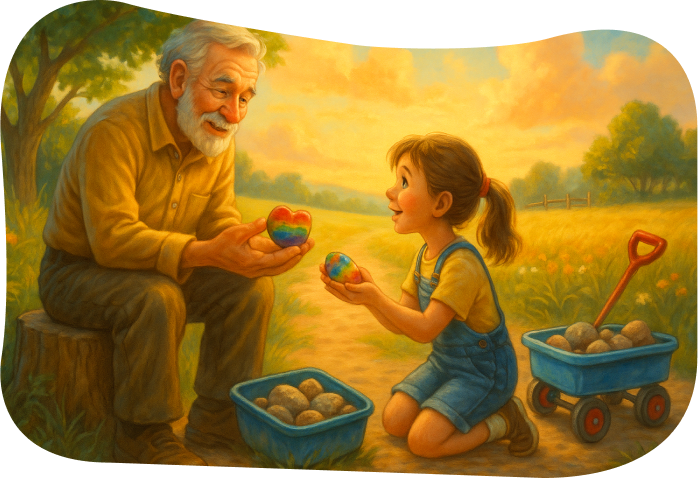
What if one kind neighbor could change the way a child sees the world? Sometimes, all it takes is a gentle smile, a small gift, or a listening ear to plant a seed of kindness that grows for a lifetime. In Karen R. Sullivan’s The Blue Wagon, this role belongs to Mr. Wiggledimp—an elderly man with a funny name, a generous heart, and wisdom that flows as naturally as the stories of his childhood. His presence reminds us of something we often forget in our fast-paced lives: every child needs a Mr. Wiggledimp. When Heather, a six-year-old girl, sets out on her treasure hunt with her blue wagon, she expects to find rocks, crystals, and maybe a fossil or two. What she doesn’t expect is to meet a neighbor who will make her day brighter and her lesson more meaningful. Mr. Wiggledimp is not flashy or loud. He is an older man who lives down the street, and to Heather, his name alone brings joy. Children often remember such details—the quirks, the uniqueness—and to Heather, he is not just another adult. He is a friend who takes her seriously.
This is the first reason why every child needs a Mr. Wiggledimp. Children long to be noticed, not brushed aside. Mr. Wiggledimp stops to ask Heather what she is doing. He listens, and then he gives. In that small exchange, he teaches her that her world matters. One of the most powerful moments in The Blue Wagon is when Mr. Wiggledimp goes into his house and returns with a special treasure: a painted rock he has kept since boyhood. It is a rainbow of colors, a relic of his childhood that his own children no longer want. Instead of leaving it to gather dust, he passes it on to Heather. This act is far more than the sharing of an old rock. It is the handing down of memory, of joy, of meaning. Mr. Wiggledimp becomes a living bridge between generations. For Heather, the painted rock is beautiful. For him, it is a symbol of time, creativity, and sentiment. By giving it away, he shows Heather that treasures are not about material worth—they are about love, memory, and kindness. Every child needs a Mr. Wiggledimp because children thrive when kindness is modeled. Such moments teach them that giving is not about cost but about heart. They learn that sharing a piece of yourself with someone else is one of life’s greatest treasures.
Later in the story, when Heather finds a rock filled with fossils, she marvels at its uniqueness. Mr. Wiggledimp tells her that treasures are not measured by their age or value but by what they mean to the person who holds them. This is wisdom that children, and even adults, desperately need. In a world that often measures worth by numbers—grades, money, achievements—Mr. Wiggledimp stands for something different. He teaches Heather that value is personal. A rock painted with childhood joy is as meaningful as a fossil marked by dinosaurs. Both have worth because they matter to someone. Every child needs a Mr. Wiggledimp because children must learn early that they are allowed to define their own treasures. Their drawings, collections, or small achievements are worthy not because the world says so, but because they hold meaning in their hearts. What makes Mr. Wiggledimp so special is not only what he gives but how he gives it. He stops what he is doing, engages with Heather, and invests his time in her small adventure. In today’s world, where children are often told to hurry up, be quiet, or wait, his presence speaks volumes. Children need adults who notice them—not just when they succeed or fail, but in the in-between moments of curiosity, play, and discovery. Mr. Wiggledimp doesn’t just give Heather a rock; he gives her the gift of being seen. And that is something every child craves.
Karen R. Sullivan’s The Blue Wagon suggests that the book is also for the adult inner child. Many of us carry wagons filled with our own rocks—burdens of worry, regret, or responsibility. In meeting Mr. Wiggledimp on the page, adults are reminded of the people in their past who once showed them kindness. Maybe it was a teacher, a grandparent, a neighbor, or a coach. These figures often shape us more deeply than we realize. Adults reading the story may ask themselves: Who was my Mr. Wiggledimp? And how can I become one for the children around me? This reflection is part of the book’s symbolic strength. It urges us not only to remember but also to act. The truth is, every child may not naturally have a Mr. Wiggledimp in their lives. But that is where we, as adults, come in. We can choose to step into that role for the children we know—our own, our students, our neighbors, or even a child we meet briefly at the park or in our community. To be a Mr. Wiggledimp is simple. It means listening when a child wants to share their “treasures,” no matter how small they may seem. It means giving of yourself, whether through your time, your kindness, or even a story from your own past. It means affirming that their discoveries matter and, more importantly, that they themselves matter.
Quick Links
Useful Links
Copyright © 2025 Karen Sullivan. All Rights Reserved.